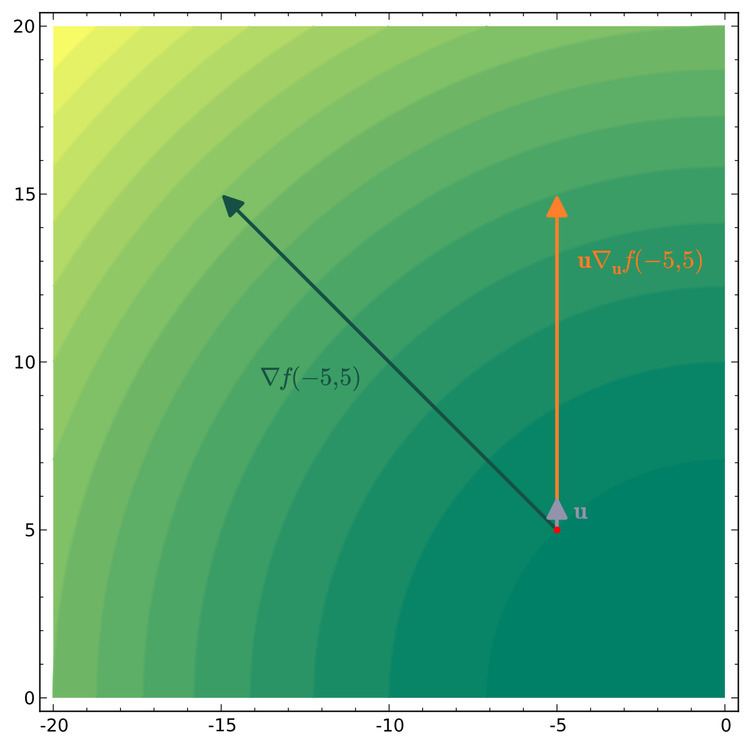 | ||
In mathematics, the directional derivative of a multivariate differentiable function along a given vector v at a given point x intuitively represents the instantaneous rate of change of the function, moving through x with a velocity specified by v. It therefore generalizes the notion of a partial derivative, in which the rate of change is taken along one of the curvilinear coordinate curves, all other coordinates being constant.
Contents
- Definition
- Variation using only direction of vector for Euclidean space
- Notation
- Properties
- In differential geometry
- The Lie derivative
- The Riemann tensor
- Translations
- Rotations
- Normal derivative
- In the continuum mechanics of solids
- Derivatives of scalar valued functions of vectors
- Derivatives of vector valued functions of vectors
- Derivatives of scalar valued functions of second order tensors
- Derivatives of tensor valued functions of second order tensors
- References
The directional derivative is a special case of the Gâteaux derivative.
Definition
The directional derivative of a scalar function
along a vector
is the function defined by the limit
In the context of a function on a Euclidean space, some texts restrict the vector v to being a unit vector. Without the restriction, this definition is valid in a broad range of contexts, for example where the norm of a vector (and hence a unit vector) is undefined.
If the function f is differentiable at x, then the directional derivative exists along any vector v, and one has
where the
Variation using only direction of vector for Euclidean space
Some authors define the directional derivative to be with respect to an arbitrary nonzero vector v after normalization, thus being independent of its magnitude and depending only on its direction.
This definition gives the rate of increase of f per unit of distance moved in the given direction. In this case, one has
or in case f is differentiable at x,
Notation
Directional derivatives can be also denoted by:
where v is a parameterization of a curve to which v is tangent and which determines its magnitude.
Properties
Many of the familiar properties of the ordinary derivative hold for the directional derivative. These include, for any functions f and g defined in a neighborhood of, and differentiable at, p:
In differential geometry
Let M be a differentiable manifold and p a point of M. Suppose that f is a function defined in a neighborhood of p, and differentiable at p. If v is a tangent vector to M at p, then the directional derivative of f along v, denoted variously as df(v) (see Exterior derivative),
This definition can be proven independent of the choice of γ, provided γ is selected in the prescribed manner so that γ′(0) = v.
The Lie derivative
The Lie derivative of a vector field
In particular, for a scalar field
The Riemann tensor
Directional derivatives are often used in introductory derivations of the Riemann curvature tensor. Consider a curved rectangle with an infinitesimal vector δ along one edge and δ′ along the other. We translate a covector S along δ then δ′ and then subtract the translation along δ′ and then δ. Instead of building the directional derivative using partial derivatives, we use the covariant derivative. The translation operator for δ is thus
and for δ′
The difference between the two paths is then
It can be argued that the noncommutativity of the covariant derivatives measures the curvature of the manifold:
with R the Riemann tensor of course and the sign depending on the sign convention of the author.
Translations
In the Poincaré algebra, we can define an infinitesimal translation operator P as
(the i ensures that P is a self-adjoint operator) For a finite displacement λ, the unitary Hilbert space representation for translations is
By using the above definition of the infinitesimal translation operator, we see that the finite translation operator is an exponentiated directional derivative:
This is a translation operator in the sense that it acts on multivariable functions f(x) as
Rotations
The rotation operator also contains a directional derivative. The rotation operator for an angle θ, i.e. by an amount θ=|θ| about an axis parallel to
Here L is the vector operator that generates SO(3):
It may be shown geometrically that an infinitesimal right-handed rotation changes the position vector x by
So we would expect under infinitesimal rotation:
It follows that
Following the same exponentiation procedure as above, we arrive at the rotation operator in the position basis, which is an exponentiated directional derivative:
Normal derivative
A normal derivative is a directional derivative taken in the direction normal (that is, orthogonal) to some surface in space, or more generally along a normal vector field orthogonal to some hypersurface. See for example Neumann boundary condition. If the normal direction is denoted by
In the continuum mechanics of solids
Several important results in continuum mechanics require the derivatives of vectors with respect to vectors and of tensors with respect to vectors and tensors. The directional directive provides a systematic way of finding these derivatives.
The definitions of directional derivatives for various situations are given below. It is assumed that the functions are sufficiently smooth that derivatives can be taken.
Derivatives of scalar valued functions of vectors
Let
for all vectors
Properties:
Derivatives of vector valued functions of vectors
Let
for all vectors
Properties:
Derivatives of scalar valued functions of second-order tensors
Let
for all second order tensors
Properties:
Derivatives of tensor valued functions of second-order tensors
Let
for all second order tensors
Properties:
